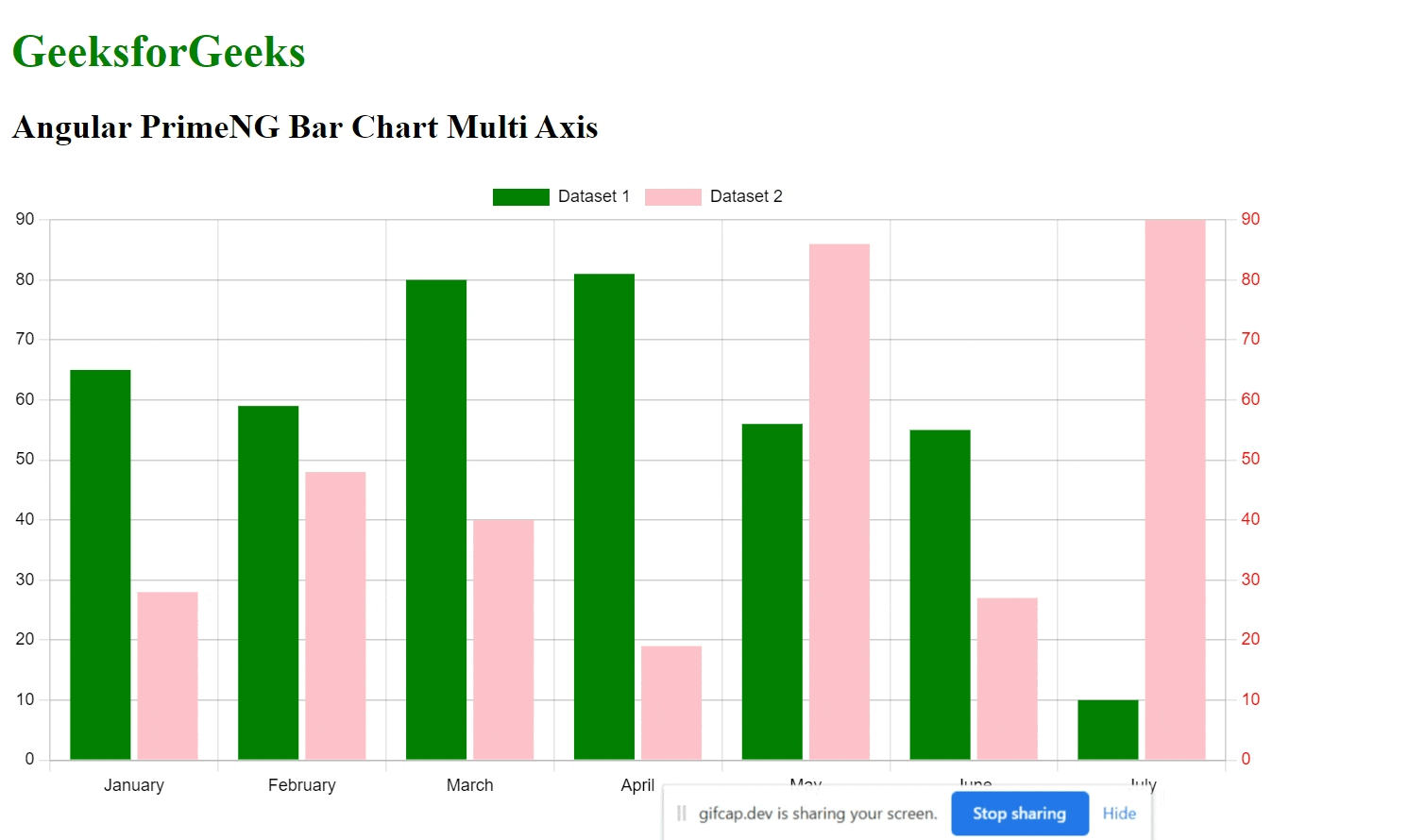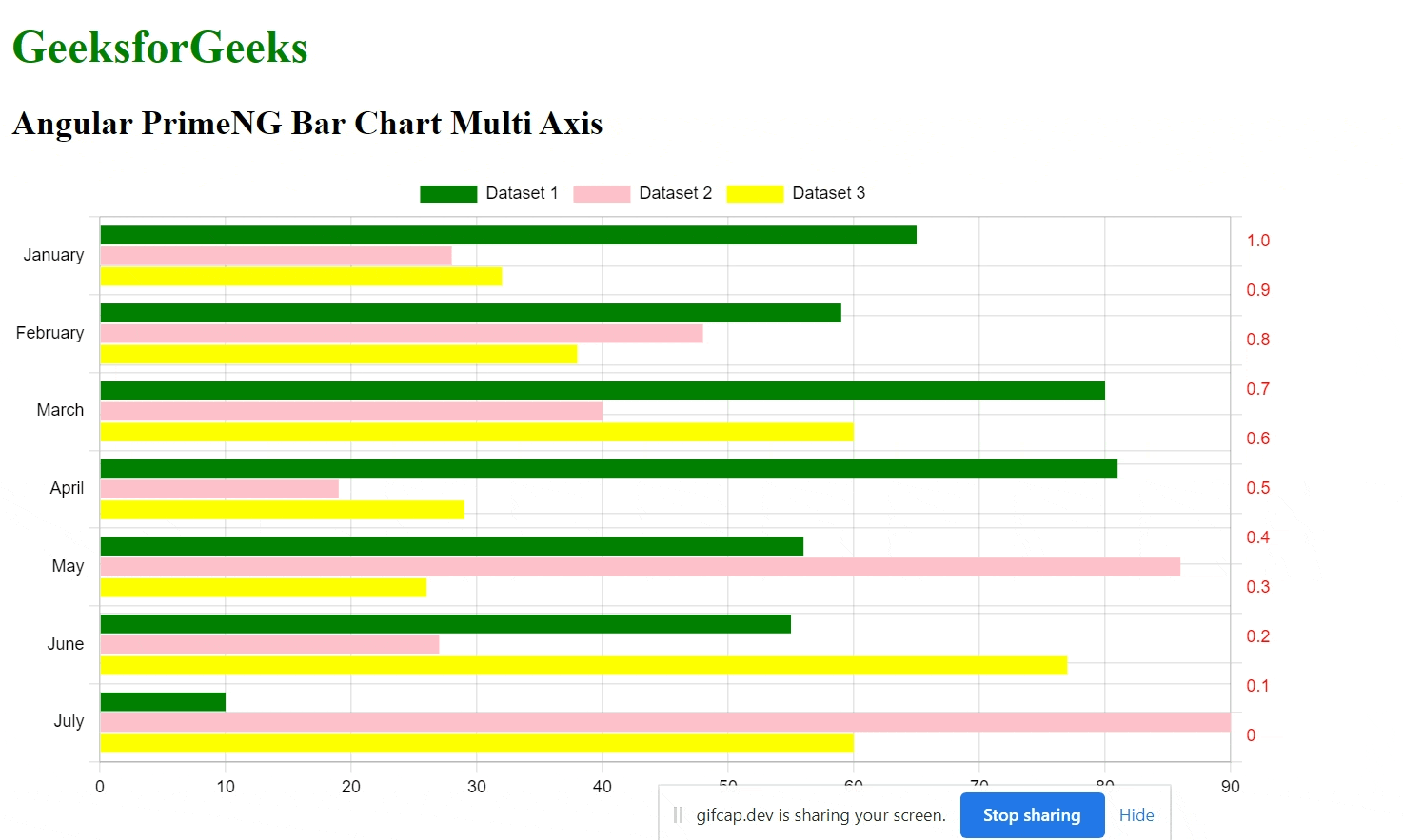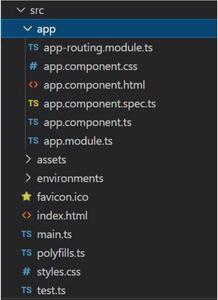Angular PrimeNG BarChart多轴图
Angular PrimeNG是一个开源框架,它有丰富的原生Angular UI组件,可以用来做很好的造型,这个框架用来做响应式网站非常方便。在这篇文章中,我们将看到Angular PrimeNG中的BarChart Multi Axis。
柱状图或条形图是一种以矩形柱状形式表示分组数据的图表,其长度与它们所代表的值成正比。在多轴条形图中,可以使用属性AxisID.为数据集分配一个自定义的轴。
创建Angular应用程序和模块安装。
第1步:使用以下命令创建一个Angular应用程序。
ng new appname
第2步:在创建你的项目文件夹即appname后,使用以下命令移动到它。
cd appname
第3步:在你给定的目录中安装PrimeNG。
npm install primeng --save
npm install primeicons --save
npm install chart.js --save
项目结构:它将看起来像如下。
例子1:这个例子描述了Angular PrimeNG中BarChart多轴的基本用法。在这里,我们将为数据集1提供‘y’轴,为数据集2提供‘y1’轴。
- app.component.html
<div id="GFG">
<h1 style="color:green">GeeksforGeeks</h1>
<h2>Angular PrimeNG Bar Chart Multi Axis</h2>
<div style="width:70%;">
<p-chart type="bar"
[data]="basicData"
[options]="multiAxisOptions">
</p-chart>
</div>
</div>
- app.component.ts
import { Component } from '@angular/core';
@Component({
selector: 'app-root',
templateUrl: './app.component.html',
styleUrls: ['./app.component.css']
})
export class AppComponent {
title = 'GFG';
basicData = {
labels: ['January', 'February', 'March',
'April', 'May', 'June', 'July'],
datasets: [{
label: 'Dataset 1',
backgroundColor: 'green',
yAxisID: 'y',
data: [65, 59, 80, 81, 56, 55, 10]
}, {
label: 'Dataset 2',
backgroundColor: 'pink',
yAxisID: 'y1',
data: [28, 48, 40, 19, 86, 27, 90]
}]
}
multiAxisOptions = {
plugins: {
legend: {
labels: {
color: '#black'
}
},
tooltips: {
mode: 'index',
intersect: true
}
},
scales: {
x: {
ticks: {
color: '#black'
},
},
y: {
type: 'linear',
display: true,
position: 'left',
ticks: {
min: 0,
max: 100,
color: '#black'
},
},
y1: {
type: 'linear',
display: true,
position: 'right',
ticks: {
min: 0,
max: 100,
color: 'red'
}
}
}
};
}
- app.module.ts
import { NgModule } from '@angular/core';
import { BrowserModule }
from '@angular/platform-browser';
import { AppComponent } from './app.component';
import { ChartModule } from 'primeng/chart';
@NgModule({
declarations: [
AppComponent,
],
imports: [
BrowserModule,
ChartModule
],
providers: [],
bootstrap: [AppComponent]
})
export class AppModule { }
输出:

例子2:在这个例子中,我们将显示3个数据集,并使用indexAxis属性将方向改为垂直。
- app.component.html
<div id="GFG">
<h1 style="color:green">GeeksforGeeks</h1>
<h2>Angular PrimeNG Bar Chart Multi Axis</h2>
<div style="width:70%;">
<p-chart type="bar"
[data]="basicData"
[options]="multiAxisOptions">
</p-chart>
</div>
</div>
- app.component.ts
import { Component } from '@angular/core';
@Component({
selector: 'app-root',
templateUrl: './app.component.html',
styleUrls: ['./app.component.css']
})
export class AppComponent {
title = 'GFG';
basicData = {
labels: ['January', 'February', 'March',
'April', 'May', 'June', 'July'],
datasets: [{
label: 'Dataset 1',
backgroundColor: 'green',
AxisID: 'x',
data: [65, 59, 80, 81, 56, 55, 10]
}, {
label: 'Dataset 2',
backgroundColor: 'pink',
AxisID: 'x1',
data: [28, 48, 40, 19, 86, 27, 90]
},
{
label: 'Dataset 3',
backgroundColor: 'yellow',
AxisID: 'x',
data: [32, 38, 60, 29, 26, 77, 60]
}
]
}
multiAxisOptions = {
indexAxis: 'y',
plugins: {
legend: {
labels: {
color: '#black'
}
},
tooltips: {
mode: 'index',
intersect: true
}
},
scales: {
y: {
ticks: {
color: '#black'
},
},
x: {
type: 'linear',
display: true,
position: 'left',
ticks: {
min: 0,
max: 100,
color: '#black'
},
},
x1: {
type: 'linear',
display: true,
position: 'right',
ticks: {
min: 0,
max: 100,
color: 'red'
}
}
}
};
}
- app.module.ts
import { NgModule } from '@angular/core';
import { BrowserModule }
from '@angular/platform-browser';
import { AppComponent } from './app.component';
import { ChartModule } from 'primeng/chart';
@NgModule({
declarations: [
AppComponent,
],
imports: [
BrowserModule,
ChartModule
],
providers: [],
bootstrap: [AppComponent]
})
export class AppModule { }
输出:

 极客教程
极客教程